A) A body at rest persists in its state of rest unless acted on by a non-zero net external force.
B) A body persists in its state of rest or of uniform motion in a straight line as long as the net external force remains constant.
C) For every action there is an equal and opposite reaction.
D) A body persists in its state of rest or of uniform motion in a straight line unless acted on by a non-zero net external force.
E) The acceleration of a body is proportional to the net external force acting on it and to the mass of the body.
G) B) and C)
Correct Answer

verified
Correct Answer
verified
Multiple Choice
The weight of an object is
A) the same as the mass of the object.
B) the quantity of matter in the object.
C) the mass of the object multiplied by the acceleration due to gravity at sea level,regardless of where the object is located.
D) the result of the gravitational force acting on the object.
E) the reading on a spring scale attached to the object.
G) A) and B)
Correct Answer

verified
Correct Answer
verified
Multiple Choice
A physical quantity that is sometimes described as the measure of the resistance of a body to a change in motion is
A) force
B) mass
C) acceleration
D) weight
E) friction
G) A) and B)
Correct Answer

verified
Correct Answer
verified
Multiple Choice
The figure below shows two forces,F1< / sub> and F2< / sub>,acting on an object. 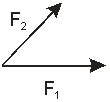 Use the vector diagrams to answer the question.
Use the vector diagrams to answer the question.  -A third force is applied on the object so that the net force on the object is zero.Which force vector best represents the third force?
-A third force is applied on the object so that the net force on the object is zero.Which force vector best represents the third force?
A) (1)
B) (2)
C) (3)
D) (4)
E) none of the vectors
G) B) and C)
Correct Answer

verified
Correct Answer
verified
Multiple Choice
If two metal blocks of different masses slide freely down the same frictionless incline,which one of the following is true?
A) They have equal accelerations
B) They have unequal accelerations,but the forces acting on them are equal.
C) The more massive block reaches the bottom first.
D) The less massive block reaches the bottom first.
E) None of these is correct.
G) A) and C)
Correct Answer

verified
Correct Answer
verified
Multiple Choice
A horse-drawn coach is decelerating at 3.0 m/s2 while moving in a straight line horizontally.A 350-g mass is hanging on a string 1.6 m long from the ceiling of the coach.The angle that the string makes with the vertical is
A) 9.3º toward the front of the coach.
B) 17º toward the front of the coach.
C) 9.3º toward the back of the coach.
D) 2.5º toward the front of the coach.
E) 0º,or straight down.
G) All of the above
Correct Answer

verified
Correct Answer
verified
Multiple Choice
A person of weight w is in an upward-moving elevator when the cable suddenly breaks.What is the person's apparent weight immediately after the elevator starts to fall?
A) w
B) greater than w
C) less than w
D) 9.81w
E) zero
G) B) and E)
Correct Answer

verified
Correct Answer
verified
Multiple Choice
A force accelerates a body of mass M.A second body requires twice as much force to produce the same acceleration.What is the mass of the second body?
A) M
B) 2M
C) M/2
D) 4M
E) M/4
G) B) and C)
Correct Answer

verified
Correct Answer
verified
Multiple Choice
Two groups of five men each are engaged in a tug-of-war,each man pulling with a force of 900 N.If the rope does not move,the tension in it is
A) 18 kN
B) 9.0 kN
C) 44 kN
D) 4.5 kN
E) 0.46 kN
G) A) and B)
Correct Answer

verified
Correct Answer
verified
Multiple Choice
A net force is exerted on an object toward the north.The object
A) is moving toward the north.
B) is moving toward the east.
C) is moving toward the west.
D) is moving toward the south.
E) may be moving in any direction.
G) B) and D)
Correct Answer

verified
Correct Answer
verified
Multiple Choice
You want to elope by sliding down a nylon rope made by tying stockings together.The rope will withstand a maximum tension of 300 N without breaking.Your mass is 61.2 kg.The magnitude of the smallest acceleration a with which you can slide down the rope is
A) 9.81 m/s2
B) 4.91 m/s2
C) zero
D) 2.40 m/s2
E) 19.6 m/s2
G) A) and B)
Correct Answer

verified
Correct Answer
verified
Multiple Choice
A frictionless pulley of negligible mass is hung from the ceiling using a rope,also of negligible mass.Two masses,m1 and m2 (m1 < m2) are connected to the rope over the pulley.The masses are free to drop.The magnitude of the tension Ttop is ____ the sum of the tensions T1 and T2. 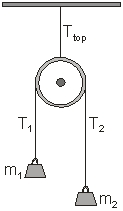
A) less than
B) equal to
C) greater than
D) unable to tell
E) depends on Ttop
G) C) and D)
Correct Answer

verified
Correct Answer
verified
Multiple Choice
Which of the following is not a unit of mass?
A) pound
B) kilogram
C) gram
D) slug
E) milligram
G) B) and E)
Correct Answer

verified
Correct Answer
verified
Multiple Choice
The force needed to accelerate "Opportunity" (Opportunity is a Mars rover) on Mars at 1 m/s2 in the horizontal direction is ____ the force needed to accelerate the rover while it was undergoing testing on Earth.
A) less than
B) equal to
C) greater than
D) unable to tell
E) depends on what g is on Mars
G) A) and B)
Correct Answer

verified
Correct Answer
verified
Multiple Choice
A lamp of mass m hangs from a spring scale which is attached to the ceiling of an elevator.When the elevator is stopped at the fortieth floor,the scale reads mg.What does it read as the elevator slows down to stop at the ground floor?
A) more than mg
B) less than mg
C) mg
D) zero
E) One cannot tell without knowing how fast the elevator is stopping.
G) B) and E)
Correct Answer

verified
Correct Answer
verified
Multiple Choice
A force of F = 90 N is exerted on mass m1 as shown.Both m1 and m2 accelerate to the right at 3 m/s2 along the frictionless surface.The force F makes an angle of 25 degrees to the horizontal.Calculate the force that the horizontal surface exerts on mass m1.(m2 = 10 kg) 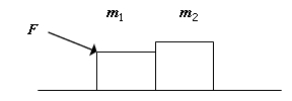
A) 2.5 102 N
B) 1.5 102 N
C) 82 N
D) 3.5 102 N
E) 2.1 102 N
G) All of the above
Correct Answer

verified
Correct Answer
verified
Multiple Choice
A lamp with a mass m is suspended from the ceiling by two cords as shown.The ratio of the magnitude of the vertical component of the tension in  2 to that in
2 to that in  3 is
3 is 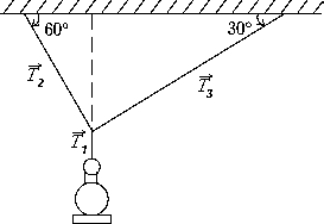
A) 1:1
B) 1:2
C) ![]()
D) 3:2
E) 3:1
G) A) and E)
Correct Answer

verified
Correct Answer
verified
Multiple Choice
A frictionless pulley of negligible mass is hung from the ceiling using a rope,also of negligible mass.Two masses,m1 and m2 (m1 < m2) are connected to the rope over the pulley.The masses are free to drop.The magnitude of the tension Ttop is ____ the sum of the weights W1 = m1g and W2 = m2g. 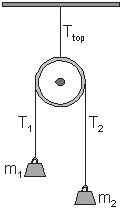
A) less than
B) equal to
C) greater than
D) unable to tell
E) depends on T1 and T2.
G) C) and D)
Correct Answer

verified
Correct Answer
verified
Multiple Choice
The diagrams below show the application of a force F on a block of mass m.  Which diagram(s) produces the largest acceleration on the block in the horizontal direction?
Which diagram(s) produces the largest acceleration on the block in the horizontal direction?
A) (1) and (3)
B) (2)
C) (3)
D) (2) and (4)
E) The acceleration is the same for all four.
G) A) and E)
Correct Answer

verified
Correct Answer
verified
Multiple Choice
According to Newton's law of inertia,
A) objects moving with an initial speed relative to a given frame of reference eventually come to rest relative to the reference frame.
B) whether an object is at rest or is moving with constant velocity depends on the inertial reference frame in which the object is observed.
C) rest is the most natural state of motion.
D) an object at rest in a given frame of reference eventually finds itself in motion relative to the frame of reference.
E) forces always exist in pairs.
G) A) and D)
Correct Answer

verified
Correct Answer
verified
Showing 61 - 80 of 106
Related Exams